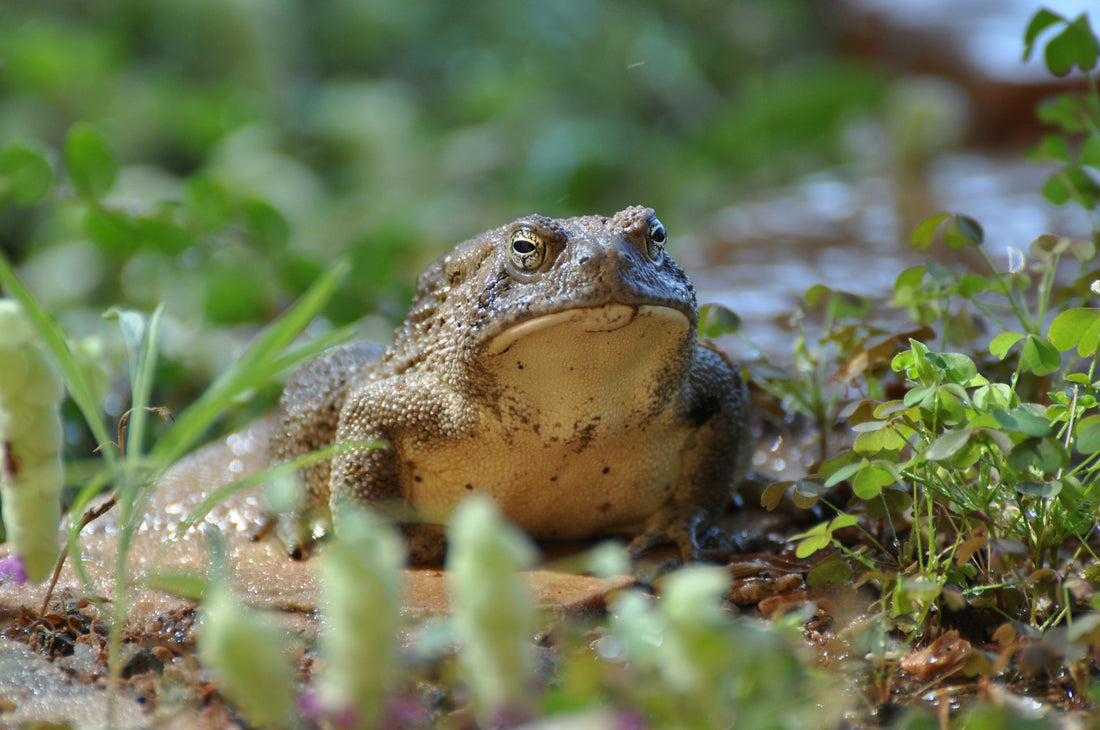While birds, butterflies, and bugs usually take the spotlight in discussions about garden wildlife, garden toads are an overlooked but incredibly valuable addition to any backyard ecosystem. These cute and quirky amphibians provide essential services like natural pest control and acting as environmental indicators.
Frog or Garden Toad: Understanding the Distinction
Toads are amphibians closely related to frogs, with about two dozen species found in North America. Unlike their aquatic counterparts, toads have adapted to live in drier land environments. They have dry skin, rounded bodies, blunt noses, and short legs that they use for walking as often as hopping.
Most toads have tan, brown, or gray coloration to blend in with their surroundings. They also have bumps on their skin, which are called parotoid glands. Contrary to popular belief, these bumps are not warts but actually produce toxins that protect toads from predators.
Garden Toads As Natural Pest Control
One of the most significant benefits of having garden toads in your yard is their voracious appetite for pests. Toads are strictly carnivorous and feed on a variety of insects and invertebrates such as beetles, slugs, crickets, flies, and ants. Some larger toad species even consume small rodents and snakes.
A single toad can consume as many as 100 insects per night, providing a natural and effective form of pest control. With a healthy toad population in your yard, you can say goodbye to unwanted pests and reduce the need for chemical pesticides.
Toads as Environmental Indicators
Toads, like all amphibians, are highly susceptible to environmental toxins. Their permeable skin readily absorbs pesticides, chemical fertilizers, and other pollutants. If exposed to unhealthy levels of these substances, toads cannot survive.
Therefore, the presence of toads in your yard can serve as a positive indication of a clean and healthy environment. By creating a welcoming habitat for toads, you are not only benefiting these fascinating creatures but also contributing to the overall well-being of your local ecosystem.
How To Create A Toad-Friendly Yard
Although garden toads don't rely on plants for food, they do benefit from them. Native plants offer habitats for natural insect populations, which serve as a toad's primary food source. Additionally, plants provide toads with cover to hide from predators. Creating a toad-friendly yard involves several key steps:
- To attract toads, it's essential to create a diverse and wildlife-friendly garden. Replace large expanses of mowed grass lawns with strategically landscaped areas using native plants. Native plants not only provide food and shelter for toads but also require less watering and maintenance compared to exotic species. Incorporate natural garden beds filled with native plants to create a welcoming environment for toads and other wildlife.
- Toads need plenty of cover to hide from predators and stay protected. Incorporate elements in your yard that offer shelter to toads, such as leaf and brush piles, low-growing native shrubs, and un-mowed areas. Creating a brush or rock pile and leaving a layer of fallen leaves will provide ideal hiding places for toads. Additionally, consider adding toad houses, which can be made by half-burying a terracotta pot in a shady and damp area of your yard. Multiple toad houses spread throughout your yard can accommodate territorial toads and provide moist cover.
- While toads don't spend much time in water, they still require fresh water to drink daily and use for breeding. Consider adding a small pond with vegetation and easy access to water in your yard. Even shallow ground-level bird baths in sheltered areas can serve as water sources for toads. Ensure that the water is clean and free of chemicals, as toads' permeable skin makes them susceptible to toxins.
- To protect the health of toads and maintain a thriving ecosystem, it's crucial to eliminate the use of pesticides, insecticides, and fertilizers in your yard. These chemicals not only harm toads directly but also eliminate their primary food source, insects. Opt for natural pest control methods and organic gardening practices to create a safe and welcoming environment for toads and other beneficial wildlife.
Creating a Toad Abode: DIY Toad Houses
If you're feeling crafty and want to provide additional shelter for toads, consider creating a DIY toad house. Here are three simple and creative ideas for toad houses:
- Half-bury a large flowerpot on its side to create a cozy shelter.
- Tip a flowerpot upside down and prop one side up with a few rocks to create an entrance.
- Gather flat rocks and build a toad-sized house using them.



